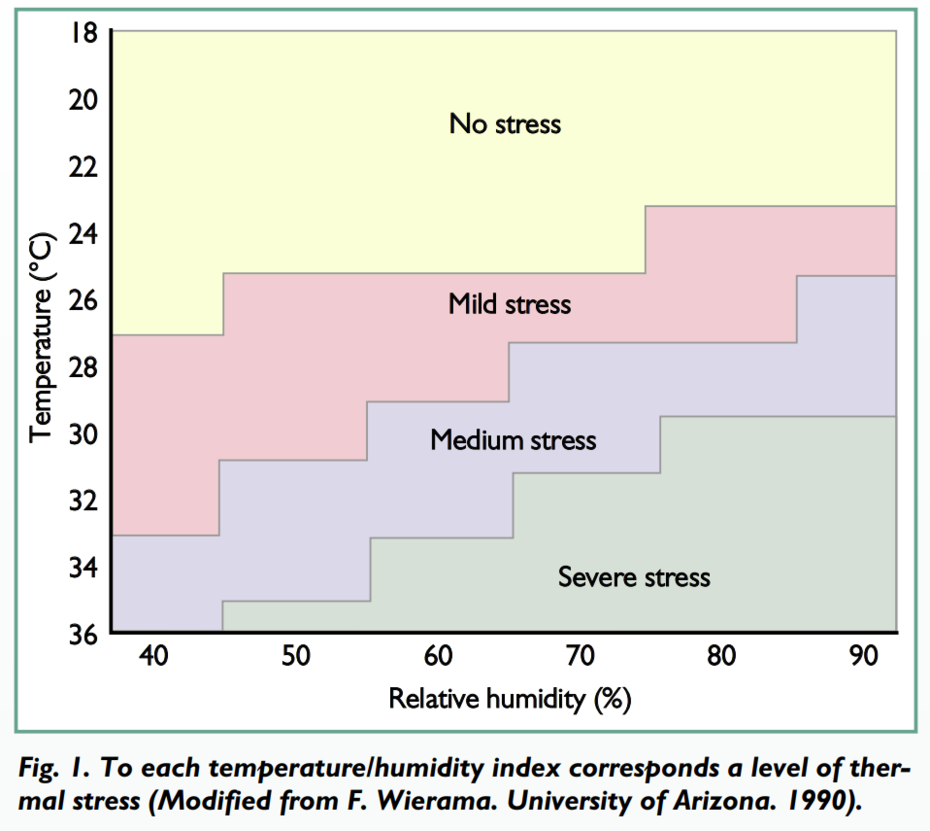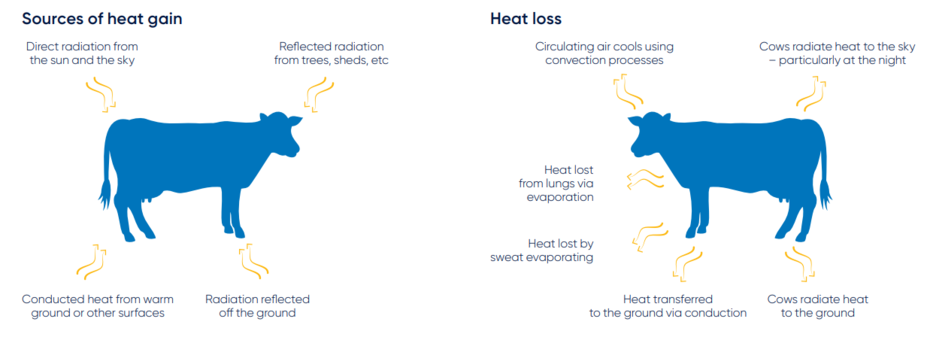Posted September 27, 2021
Heat stress in dairy cows is a challenge that dairy farmers face each year during the warmer months. Seasonal conditions can greatly affect production, cow health, and performance. Management of heat stress in dairy herds is critical to minimise production losses and to ensure good animal welfare.
Heat Load
Heat stress is a physiological response of an animal to the thermal environment when the animal produces more heat than it can dissipate. Cattle generate endogenous heat in the course of metabolic processes and are subjected to exogenous heat sources, such as temperature, humidity, and solar radiation. A cow’s ability to expel heat from its body through thermoregulation will determine its heat load status (See Figure 1 on the left).
The normal core temperature of a cow in a comfortable, thermoneutral environment is between 38.6 and 39.1°C. Core temperature changes slightly throughout the day, reaching a peak in the early evening and a low in the early morning. If the air temperature overnight is cool enough, cattle can disperse the heat load that has accumulated in their body throughout the heat of the day. If cattle are unable to adequately reduce their heat load overnight, effects will be seen from the heat accumulation cycle (See Figure 2 on the left).\
Some cows are more at risk of heat stroke than others, including:
- High producing cows and Holstein-Friesians
- Larger and/or older cows
- Cows with a black coat colour
- Cows required to walk further or on hilly terrain
- Cows not preconditioned to hot weather
Warning Signs and Impact
Heat stress begins to affect a cow when the heat that it accumulates through metabolic processes is greater than the heat that it is able to expel. This is compounded by certain environmental conditions. Heat stressed cows can be visually identified by heavy open-mouth panting, drooling saliva, sweating, shade seeking behavior, increased water intake and decreased feed intake. At this point, the heat load on the herd is at a critical point.
Often, the physiological effects of heat stress occur before the physical symptoms are very noticeable. These include a rise of core body temperature, changes in blood hormone concentrations, increased blood flow to the skin and conversely, decreased blood flow to the organs.
These physiological changes can lead to:
- Reduced dry matter and, therefore, reduced nutrient and energy intake
- Reduced milk literage by 10-25%, and poorer milk quality, particularly protein content
- Impaired rumen balance and function, resulting in increased risk of acidosis
- Reduced expression of oestrus, fertility and calving rates
- Reduced immune function, which can lead to increased instances of mastitis
- Loss in body condition
Heat Stress and Nutrition
A heat stressed cow will reduce their dry matter intake by 10-20%. This will be ongoing for however long the heat stress occurs. Dispersing heat is a very energy intensive process, therefore, compounding the effects of reduced dry matter intake and reduced nutrient intake.
It is recommended to feed a more nutrient dense bail feed and better quality roughage during the warmer months to offset reduced daily feed intake. This will minimize effects on milk production and body condition score in the herd.
Fibre digestion can increase heat load quite significantly, particularly if the source of roughage is very lignified and bulky. Roughage is essential to a ruminant’s diet to maintain rumen stability and must be fed at all times, especially during times where acidosis is a risk. To reduce endogenous heat production during the warmer months, feeding a higher quality, more digestible, source of roughage will be beneficial.
Protein content of the bail and/or feed-pad ration should be increased during summer to compensate for cows eating less. Cattle will eat less overall, including reduced grazing of the paddock. Grass may look abundant when making a visual assessment, however, heat stressed cattle are in a physiological state which inhibits intake and, therefore, are not fulfilling their daily nutrient requirements. Reduced dry matter intake often leads to a negative crude protein balance — providing a higher protein bail feed will assist in balancing the diet.
Betaine supplementation has numerous functions that may decrease the effect of heat stress in dairy cows and increase milk production. Betaine has the potential to reduce heat stress by reducing energy expenditure, thereby reducing metabolic heat production and maintaining osmotic balance in animals facing heat stress.
Adding a by-pass fat in the ration can be helpful as it increases the overall energy in the ration. Digestion of fat produces less metabolic heat than digestion of fibre and starch. This approach will not be suitable for all situations.
Nutrition has a part to play in minimising the effects of heat stress come the hotter months of the year, but management of the dairy herd in hot conditions is most important in reducing heat stress.
Management Strategies
Managing the milking herd is critical to mitigating heat stress. Here are some management tips to consider:
- Providing shade in the dairy is most important
- Reduce walking distance during the heat of the day – choose paddocks close to the dairy
- Delay afternoon milking until the day cools down
- Provide access to water while in the holding yard and along the laneway
- Consider installing sprinklers and fans in the dairy to keep cows cool
- Avoid joining in hot summer months when silent or shortened oestrus is likely
Please see the Cool Cows Manual from Dairy Australia for more tips.
If you would like to learn more about heat stress management in dairy cows, reach out to our Nutrition Team.
Amy is a nutritionist at Riverina Australia and has a Bachelor’s degree in Science, specialising in Animal Science and Animal Health.
References
Heat Stress. Dairyaustralia.com.au. www.dairyaustralia.com.au/gippsdairy/animal-management-and-milk-quality/animal-health/heat-stress. Published 2021.
Toledo I, Dahl G. Recognizing Heat Stress in Dairy Cows. EDIS. 2019;2019(4):2. doi:10.32473/edis-an356-2019
Heat Stress In Dairy Cows: Implications And Nutritional Management. The Cattle Site. www.thecattlesite.com/articles/1053/heat-stress-in-dairy-cows-implications-and-nutritional-management/. Published 2007.
Conte G, Ciampolini R, Cassandro M et al. Feeding and nutrition management of heat-stressed dairy ruminants. Italian Journal of Animal Science. 2018;17(3):604-620. doi:10.1080/1828051x.2017.1404944
Liu J, Li L, Chen X, Lu Y, Wang D. Effects of heat stress on body temperature, milk production, and reproduction in dairy cows: a novel idea for monitoring and evaluation of heat stress — A review. Asian-Australas J Anim Sci. 2019;32(9):1332-1339. Published 2019 Jan 4. doi:10.5713/ajas.18.0743
Shah AM, Ma J, Wang Z, Zou H, Hu R, Peng Q. Betaine Supplementation Improves the Production Performance, Rumen Fermentation, and Antioxidant Profile of Dairy Cows in Heat Stress. Animals (Basel). 2020;10(4):634. Published 2020 Apr 7. doi:10.3390/ani10040634






 Beef
Beef
 Dairy
Dairy
 Sheep
Sheep
 Horse
Horse
 Pig
Pig
 Goat
Goat
 Poultry
Poultry
 Bird
Bird
 Dog
Dog
 Special
Special
 Feed Materials
Feed Materials